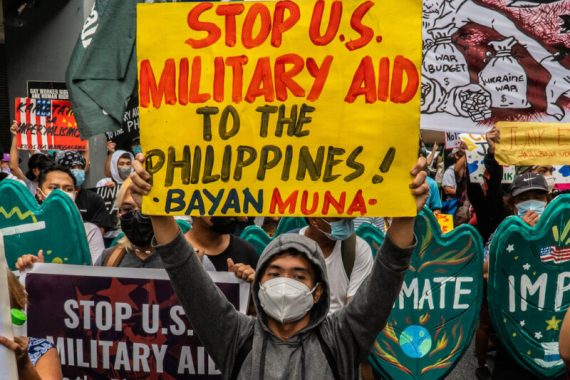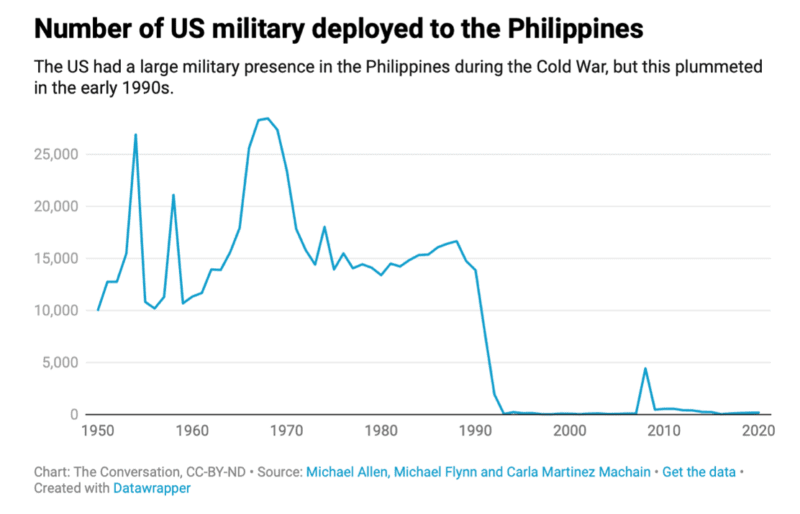T
he agreement between the Philippines and the United States aims to strengthen U.S. defense capabilities to counter China’s aggressive territorial presence in the Asia-Pacific region.
According to the agreement announced on February 2, the United States has been granted access to use four military bases in the Philippines, providing U.S. forces with greater power projection capability in the southeastern part of the South China Sea, close to self-governing Taiwan.
The newly announced pact permits Washington to place military equipment and construct facilities at nine locations across the Philippines under the Enhanced Defense Cooperation Agreement (EDCA) dating back to 2014. The new pact grants the United States the largest military presence in the country in the last 30 years.
The latest agreement is among the defense pacts resulting from the 1951 Mutual Defense Treaty, which enables the Philippines and the U.S. to collaborate in enhancing their defense capacities to respond to external armed aggression.
As a part of the deal, the U.S. had allocated $82 million for infrastructure upgrades at the five existing operational sites: Cesar Basa Air Base in Pampanga, Fort Magsaysay in Nueva Ecija, Lumbia Air Base in Cagayan de Oro, Benito Ebuen Air Base in Cebu, and Antonio Bautista Air Base in Palawan.
This agreement follows the October 2022 announcement of the U.S. providing $100 million in military aid to the Philippines.
Once implemented, the joint decision of the two allies to expand the EDCA will result in the U.S. military having access to nine military bases in the Philippines, maintaining a rotating troop presence, conducting training with Philippine troops, and positioning defense resources.
The Philippines’ Defense Secretary Carlito Galvez Jr. did not reveal the specific locations of the four additional sites and stated that the government must first consult with local officials.
U.S. vs. China?
The 2014 agreement between the U.S. and the Philippines allows the U.S. military to establish facilities on Philippine bases, store equipment, maintain aircraft and vessels, and rotate troops through the bases. The Philippine Constitution outlaws permanent foreign military bases in the country unless they are authorized by a treaty.
Due to China’s land reclamation efforts in the Indo-Pacific region, the United States has intensified its efforts to increase its defense capabilities to respond to security threats and “preserve regional peace.”
During his visit to the capital Manila on Thursday, February 2, U.S. Defense Secretary Lloyd Austin stated that both the United States and the Philippines are committed to strengthening their capability to defend against armed assaults.
Following the meeting with Philippine President Ferdinand Marcos Jr., Austin stated,
“We discussed concrete actions to address destabilizing activities in the waters surrounding the Philippines, including the West Philippine Sea, and we remain committed to strengthening our mutual capacities to resist armed attack.”
“That’s just part of our efforts to modernize our alliance, and these efforts are especially important as the People’s Republic of China continues to advance its illegitimate claims in the West Philippine Sea,” Austin continued.
The pact aims to strengthen the defense relationship between the two countries in response to growing concerns about China’s actions in the region.
Chinese response
In a regular briefing, China’s Foreign Ministry spokesperson Mao Ning commented on the U.S. action as “an act that escalates tensions in the region and endangers regional peace and stability.” She added, “Regional countries should remain vigilant about this and avoid being used by the U.S.”
The Philippines is of strategic importance to China. Having U.S. military forces on the island of Luzon, the largest and most populous island in the Philippines would enhance the U.S. capability to deter potential Chinese threats against Taiwan.
Any Chinese military attack on Taiwan will require passing through the Bashi Channel with the nearby U.S. military presence directly challenging such a passage.
Timeline of Philippines-U.S. relationship
The Philippines, formerly a Spanish colony and then an American territory before gaining independence in 1946, is the oldest of the five treaty allies of the United States in the Indo-Pacific region. It is also a vital strategic partner in areas where China is exerting military influence and constructing military facilities on contested islands.
The recent announcement seems to indicate a slight change in political stance for President Marcos who previously positioned his government as not being hostile to any country. The Philippine government has had a history of fluctuating in its approach to relations with foreign nations, and particularly with the U.S. since 1992 when it left its Subic Bay naval base.
Since taking office last June, President Marcos has sought to improve the relationship between the Philippines and the U.S. Conversely, during his campaign, Marco had signaled a desire to strengthen ties with China, which was a key aspect of former president Rodrigo Duterte’s term.
Recommended
Public resentment
The agreement has been met with some criticism from nationalist and leftist groups in the Philippines, which saw the pact as a threat to the country’s sovereignty. Outside the military headquarters, protesters who are against the U.S. military presence chanted anti-U.S. slogans while calling for the termination of the EDCA.
In a joint statement, then Philippine President Rodrigo Duterte and U.S. Secretary of Defense Lloyd Austin emphasized the importance of the U.S.-Philippine alliance and the need for increased cooperation on security and defense issues. Austin clarified that the U.S. is not seeking to establish permanent bases in the Philippines.
“This agreement represents a significant step forward in our defense relationship and will enhance our ability to work together to address shared security challenges in the Indo-Pacific region,” Secretary Austin added.






